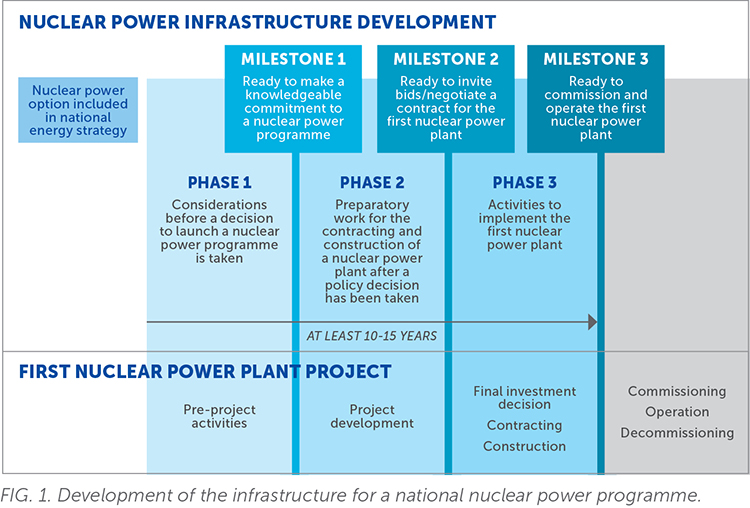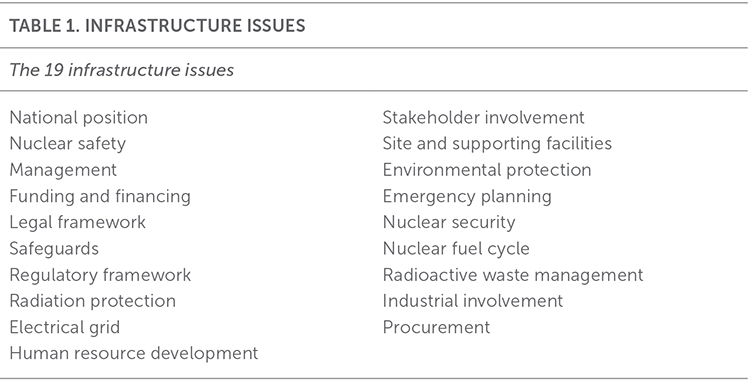Nuclear power in Africa: Spotlight on South Africa and Kenya
At a glance
- Access to affordable, reliable, and sustainable electricity is crucial for economic and social development and achieving net-zero carbon emissions targets by 2050.
- Several African countries, including Nigeria, Ghana, Kenya, and Uganda, are considering nuclear power as part of their energy mix and have begun establishing policy and regulatory frameworks for nuclear power plant development.
- South Africa aims to expand its nuclear power generation capacity, while Kenya plans to initiate the development of nuclear power plants. Both countries have taken steps to assess readiness and implement action plans based on the International Atomic Energy Agency's guidelines.
To meet these and other objectives, several African countries, such as Nigeria, Ghana, Kenya, and Uganda, are considering nuclear power as part of their electricity generation mix, and are at different stages of establishing their respective policy and regulatory frameworks for the development of new nuclear power plants (NPPs). The attraction to nuclear was noted by the Director General of the International Atomic Energy Agency (IAEA), Mr Rafeal Mariano Grossi, at the African Nuclear Business Platform’s ANBP Lite conference on 19 April 2021, who stated that “Of the nearly 30 so-called newcomer countries that are embarking [on] or considering nuclear power, almost one-third are in Africa”.
For purpose of our discussion, we highlight a summary of ongoing nuclear power developments in South Africa and Kenya, exemplifying two African countries that have demonstrated a keen interest in either expanding the contribution of nuclear power generation to the current energy mix, in the case of South Africa, or initiating the development of NPPs, in the case of Kenya.
Overview of the development requirements for a new nuclear power station
For any African country, embarking on a process of realising the production of electricity from NPPs will require significant investment in ensuring actual readiness to proceed with the various elements of a NPP project. In doing a readiness assessment, the IAEA Guide: Milestones in the Development of a National Infrastructure for Nuclear Power (No. NG-G-3.1) Rev. 1 provides a comprehensive guideline for governments that intend to embark upon a new nuclear build programme (IAEA NNBP Milestone Guide). Both South Africa and Kenya appear to have based their readiness assessments of their NPPs on the IAEA NNBP Milestone Guide by, amongst other things, requesting a review from the IAEA at different stages (based on their current capability with nuclear power generation). From the IAEA’s recommendations, the two countries have started to implement several action plans.
The IAEA NNBP Milestone Guide sets out various milestones relating to infrastructure readiness required by a country at various phases of the new nuclear build programme (NNBP) process. The milestones are depicted as follows:

During each of the milestones / phases there are 19 infrastructure issues that must be considered:

The order of the infrastructure issues in the table above does not reflect the importance thereof. Each country must decide, and consider when each of these issues will be dealt with. Every issue is important and requires careful consideration, thus different organisations within a country will need to consider which issues relate most to them and plan their work and resources accordingly.
There are three key organisations during this process:
- the Government,
- the owner / operator; and
- the regulatory body – this body must be aware of all issues.
The IAEA NNBP Milestone Guide recommends that:
- A country must carry out work required to prepare for the contracting, financing and construction of a nuclear power plant.
- A country must develop the necessary infrastructure (covering all 19 infrastructure issues) to the point of complete readiness to invite bids or negotiate a commercial contract between the owner and the supplier. The reference here to just “the owner”, rather than the “owner / operator”, reflects the possibility that a country may prefer that a sole supplier or strategic partner offer operating services as part of its proposals. In those cases, the “operator” would only be established with the conclusion of the contract negotiations at the beginning of Phase 3. This appears to be an approach that is preferred by South Africa.
- An effectively independent regulatory body should be developed to a level at which it can fulfil all of its authorisation and inspection duties.
In Phase 1, the IAEA NNBP Milestone Guide recommends the establishment of a nuclear energy programme implementing organisation (NEPIO), which must ensure overall co-ordination, engagement of all important parties, and compilation of the information and studies necessary for a knowledgeable policy decision on whether to proceed with nuclear power.
At the end of Phase 1, the NEPIO must provide a comprehensive report that, should it recommend a positive national decision, defines and justifies a national strategy for nuclear power. Any pre-feasibility study done during Phase 1 can be a significant input to the comprehensive report, although it is important that the report fully address all 19 infrastructure issues. The key NEPIO functions are listed as:
- Maintaining momentum and providing a continuing forum for communication and co-operation among the owner / operator, the grid operator, the regulatory body, relevant government agencies, legislators and other decision makers;
- Ensuring that the roles of the key organisations (i.e. the Government, the regulatory body and the owner / operator) are well defined and understood by all stakeholders;
- Ensuring that the key organisations develop in line with the project schedule;
- Ensuring that the rationale for the national decision to introduce nuclear power is well understood by all stakeholders; and
- Ensuring that the contracting approach and technical specifications remain consistent with the country’s nuclear power development strategy.
These points only set out what needs to be taken into account during Phase 1 and 2 (milestones 1 to 2) for purposes of understanding what is required to have an enabling environment for a NPP.
We now briefly set out the general status of NPPs in both South Africa and Kenya, from a policy and legal framework perspective.
South Africa
With the twelfth largest carbon emissions footprint globally (according to the recent Sixth Assessment Report published by the Intergovernmental Panel on Climate Change in 2021), South Africa has committed to a net-zero carbon economy by 2050. However, South Africa’s updated Nationally Determined Contribution under the Paris Agreement recognises that a just energy transition lies at the core of this decarbonisation strategy.
Aligned with these sentiments, the 2019 Integrated Resource Plan (2019 IRP), published in terms of the Electricity Generation Act 4 of 2006 (ERA) and which essentially constitutes South Africa’s energy demand framework, recognises nuclear as a clean energy technology with economic potential. This is because the investment in nuclear power also stimulates growth in downstream markets, such as the mining of ore and the enrichment of uranium for the power stations. The capacity and skill to enrich uranium for peace to be able to supply other African countries would also be an added benefit from an intra-Africa trade perspective. However, South Africa currently has the only operating nuclear power stations in Africa, contributing at least 4,7% of the generation capacity in South Africa, with plans to expand the contribution of nuclear post-2030. Against the significant generation capacity of coal-fired power plants to be decommissioned post-2030, and in pursuit of electricity security from a diversified energy mix, the 2019 IRP includes the decision (Decision 8) to commence preparation for a 2,500MW nuclear build programme that must be implemented at an affordable pace and modular scale.
The first preparatory step was taken in June 2020, with the Department of Mineral Resources and Energy issuing a request for information in respect of the nuclear build programme, inviting potential bidders to submit information as part of a market-testing exercise to;
“enable the department to gain insight into the cost of the programme, possible ownership structures, cost recovery, the end user cost and sustainability of the programme”.
The legal and institutional framework
Informed by its obligations under various international conventions and treaties, South Africa has an integrated institutional and regulatory framework governing nuclear power, regulating, amongst other things, the procurement processes; plant siting, design, establishment and operation; electricity generation, transmission and distribution; environmental impact assessment and management; and radioactive waste management.
Forming an overarching framework for South Africa’s nuclear energy programme, the South African Department of Energy at the time published a Nuclear Energy Policy for the Republic of South Africa in June 2008 (Nuclear Policy). Albeit dated, the Nuclear Policy recognises the importance of nuclear power in reducing greenhouse gas emissions, acknowledging it as “one of the least carbon intensive generating technologies” and thus still aligning with the 2050 net-zero emissions strategy.
As a pre-cursor to further progression of the nuclear build programme, section 34 of the ERA provides that the Minister of Mineral Resources and Energy, in consultation with the National Energy Regulatory of South Africa (NERSA), may determine that new electricity generation capacity is needed, which determination must specify the energy source for electricity generation, the buyer and seller of the electricity and the prescribed procurement process (section 34 Determination). Following the receipt of a draft Section 34 Determination from the minister for the procurement of 2,500MW of new generation capacity from nuclear, NERSA published an invitation to comment on its concurrence on 23 November 2020. NERSA recently issued its concurrence with the draft Section 34 Determination in late August 2021, but in its media statement confirmed that it is subject to certain suspensive conditions that align with the sentiments of the 2019 IRP, including that the rationality behind the 2,500MW capacity of nuclear needs to be further established. This requires a demand analysis matching the generation profile to the load profile post 2030, which will help to determine the capacity and scale at which South Africa would need to procure power from nuclear.
South Africa’s nuclear industry is otherwise predominantly regulated in terms of the National Radioactive Waste Disposal Institute Act 53 of 2008 (NRWIDIA) (discussed below), the Nuclear Energy Act 46 1999, and the National Nuclear Regulator Act 47 of 1999 (NNRA), with the Nuclear Energy Corporation of South Africa (NECSA) and the National Nuclear Regulator (NNR) established in terms of the latter two statues respectively. NECSA is primarily responsible for the promotion of nuclear energy and radiation science and technology research and development, with the NNR being tasked with the establishment of safety standards and regulatory practices to provide for the protection of persons, property and the environment against nuclear damage. It has published several regulatory requirement documents, guidelines and position papers since its establishment. The NNR also exercises regulatory control related to the safety over the full life cycle of nuclear installations, from siting to closure.
The transmission and distribution of electricity generated by nuclear power is further regulated under the ERA, and the regulations and applicable codes are issued by NERSA and have various licensing, registration, technical, safety and commercial requirements that need to be adhered to.
Addressing health and environmental safety concerns
The above framework is well complemented by various regulatory requirements addressing health and environmental safety concerns, with the underlying Nuclear Policy highlighting, above all, the principles of safety, protection of the environment and peaceful use.
In this regard, the NNRA requires that licences be obtained for the siting, constructing, and operating of a nuclear installation or nuclear installations on a site, which would include an NPP. The 2010 Regulations on Licensing of Sites for New Nuclear Installations requires preparation of a site safety report, which is a highly technical report with stringent requirements. Safety is further extensively regulated in terms of the NNRA’s regulatory publications and guidelines, as well as regulations promulgated under the NNRA pertaining to development surrounding nuclear installations; establishment of a public safety information forum by the holder of a nuclear installation licence; and safety standards and regulatory practices, amongst others. There are several proposed amendments to the NNRA by virtue of the National Nuclear Regulator Amendment Bill No. 44749 dated 22 June 2021 to expand the regulatory scope of the NNRA to include the regulation of pre-construction activities such as the preparation of a site for the construction of a nuclear facility, including initial earthworks and site levelling, preparation of construction roads, borrow areas, security infrastructure, dewatering, building of diagram wall and excavation and clearance of bedrock. The intention is to ensure that no person commences any pre-construction activities without the prior written permission of the NNR. This amendment is also in line with the recommendations by the IAEA in the INIR Mission Report dated February 2013, which deals with the infrastructure issues to be enhanced and recommends that;
“amendments to the relevant legislation, in particular to the National Nuclear Regulatory Act, should be completed and promulgated as soon as possible.”
The environmental impact assessment (EIA) process prescribed under the National Environmental Management Act 107 of 1998 (as amended) is integral to authorising nuclear installations, which requires the preparation of detailed specialist assessments in respect of various safety, health, environmental and socio-economic information relating to the site and proposed nuclear installation, informed by international best practice, and an extensive public participation process in relation to the nuclear installations to be undertaken as part of an environmental authorisation application.
Perhaps one of the most key environmental considerations in respect of nuclear power plants is the final disposal of high-level nuclear waste, which is the responsibility of the National Radioactive Waste Disposal Institute established in terms of the NRWIDIA, whose mandate is informed by national and international requirements and standards.
Kenya
Electricity generation sources in Kenya are mainly renewable, with geothermal, which generates over 40% of Kenya’s power, being the main source of energy. Though nuclear does not feature in the current electricity generation mix, plans are underway to introduce nuclear power in Kenya, and the country has taken elaborate steps to roll out its nuclear power programme, following the IAEA Milestones Approach. Kenya has signed agreements with international nuclear power developers for assistance in the deployment of nuclear power and has embarked on the process of setting up an enabling legal and institutional framework for nuclear power.
The impetus for the use of nuclear power in Kenya began in earnest in 2010, with nuclear recommended by the National Economic and Social Council to meet the country’s projected growing electricity demand due to accelerated investment in the economy. Since then, nuclear has been encouraged on the policy front as an option to enhance the production of affordable and reliable electricity in the country and meet demand for electricity both locally and within the Eastern Africa Power Pool .
Kenya’s Energy Policy, 2018, includes a focus on nuclear energy and highlights plans for the commissioning of Kenya’s first nuclear plant of 1,000MW in 2027, and additional units of 1,000MW each in 2030, 2033, and 2035. However, given delays in the granting of approvals for the country’s first NPP, indications are that the project will not be complete by 2027 as initially anticipated. The Kenyan approach to nuclear power also recognises that the nuclear power generation plan will depend on increased electricity demand in the economy, and the prioritised approach includes the use of smaller nuclear reactors established in phases to monitor growth in electricity demand and grid capability to take the additional energy.
The legal and institutional framework
The enabling legal and institutional framework for nuclear energy in Kenya has recently been updated to provide a more up-to-date framework for the regulation of nuclear technology. Changes are reflected in the Energy Act, 2019, which sets up the Nuclear Power and Energy Agency (NuPEA), as a State Corporation in the Ministry of Energy to be the nuclear energy programme implementing organisation. NuPEA replaces its predecessor, the Kenya Nuclear Electricity Board, and is mandated to promote and fast track the development of nuclear electricity in Kenya and carry out research, development and dissemination activities. NuPEA has recently developed a five-year strategic plan for 2020 to 2025, which provides a roadmap for nuclear energy development in the country.
Parliament has also enacted the Nuclear Regulatory Act, 2019 which provides a framework for nuclear safety, nuclear security and radiation protection and which introduces measures designed to enhance existing radiation protection requirements. This act repeals the 1982 Radiation Protection Act and establishes the Kenya Nuclear Regulatory Authority (KNRA) to implement its provisions. Functions of the KNRA include ensuring safe, peaceful and secure use of nuclear science and technology; regulating construction, operation, siting and decommissioning of nuclear facilities; establishing a system of regulatory control to protect people, property and environment against harmful effects of ionizing radiation.
Addressing health and environmental safety concerns
As is the case in South Africa and the world over, human health and environmental safety are a significant concern in the deployment of nuclear energy in Kenya. The country’s Environmental Policy, 2013 recommends that intensive research on nuclear energy be undertaken prior to its development due to safety and security concerns, and also provides that the precautionary principle should underpin the development of nuclear energy policies.
In addition, the Environmental Management and Coordination Act (EMCA) requires that a mandatory EIA be done prior to the commencement of power projects, categorising power and infrastructure projects such as nuclear reactors and plants as high risk. The EMCA Waste Management Regulations, 2006 further provide that disposal of any radioactive substance or waste can only be done at a designated site or plant, approved by the National Environmental Management Authority (NEMA).
Notably, NuPEA has undertaken a Strategic Environmental and Social Assessment (SESA) for Kenya’s proposed Nuclear Power Programme. The SESA report, which has been submitted to NEMA and is under validation, identifies the River Tana basin as the ideal site for the construction of a nuclear power plant. It also outlines socio-economic issues as well as environmental, occupational health and safety concerns, and sets out policy proposals needed to ensure that the Kenya’s Nuclear Power Programme is sustainably developed. Policy recommendations include the need to formulate radioactive waste management strategies as well as policies and strategies for decommissioning of nuclear and radiological facilities, highlighting the need for further clarity on how Kenya will manage its radioactive waste.
Conclusion
Amidst global recognition of the immense threats posed by climate change and the importance of all efforts to combat it, the potential of NPPs as an electricity source that could contribute to a sustainable net-zero emissions future is fundamental. Ahead of the 26th United Nations Climate Change Conference of the Parties (COP26) to be held at the end of October 2021, the Director General of the World Nuclear Association, in a letter addressed to the COP26 President, emphasised how;
“publication from the IPCC makes for sobering reading. The message from the scientific community is loud and clear: we need a dramatic step change to avert the very real harms of climate change… As the largest single source of low-carbon electricity in developed nations, nuclear energy stands ready to continue to decarbonise the world’s economy, alongside all other low carbon technologies.”
While the appetite and ambition for generation electricity from NPPs in Africa is growing, the successful implementation of a NNBP remains dependent on state readiness, as contemplated in the IAEA NNBP Milestone Guide.
Both South Africa and Kenya have evidently taken and continue to pursue the developmental steps necessary to set up enabling regulatory frameworks in pursuit of expanding (in the case of South Africa) and establishing (in the case of Kenya) their capacity to generate electricity from NPPs. Whereas the push for nuclear power in the two countries differs, with the urgent need to decarbonize the grid higher in South Africa than in Kenya, proponents for nuclear in both countries present nuclear power as a necessity for low carbon economic growth.
With the energy dialogue increasingly underpinned by net-zero emissions targets, we anticipate significant strides to be made across the African continent in attempts to reach complete points of readiness for establishing NPPs. In this regard, establishing enabling regulatory frameworks must be recognised as a single component informing countries’ levels of readiness, and investment in NPPs should be a long-term national commitment made with the complete life-cycle in mind, for human and environmental health and safety.
Matters handled
Nuclear Energy Experience on Mandates Undertaken
- Advised on the Nuclear New Build Programme. The South African Nuclear Programme was the largest procurement programme in the history of South Africa and cost upwards of R1 trillion. The South African government had determined that 9600MW of electricity should be generated via this programme, which is equal to 18% of South Africa's current installed generating capacity and as such a massive expansion. This mandate included advice on the procurement of the entire programme - which entailed enabling policy, RFP design, project agreements, contract negotiation and financial close. The procurement of nuclear technology has since been put on hold by the SA government.
- Advising preferred bidder on the DME IPP Peaking Project within South Africa including all regulatory aspects and the construction, financing, operating and maintenance, power purchase agreement and fuel supply, including fuel supply (coal, gas, water, diesel, nuclear) arrangements.
- Advising on the construction, financing and maintenance of conventional and nuclear fuelled power stations including the procurement of goods and services across the nuclear fuel value chain.
- Advising on the development, financing, construction, operation and maintenance of an IPP nuclear power station in South Africa under the Nuclear 1 programme. Advice includes the full nuclear fuel cycle.
- Advised a major power utility on the procurement, construction, conversion, enrichment, fabrication and maintenance services for a nuclear power plant from both within and outside of South Africa.
- Advised a major power utility on the storage of spent nuclear fuel including re-racking of spent fuel pools.
- Advised a major power utility on the placing of nuclear liability insurance taking into account prevailing legislation and applicable international treaties.
- Advised a national utility entity on the procurement, construction, conversion, enrichment, fabrication and maintenance services for a nuclear power plant.
- Advising IDC / Arengo on the development, financing, construction and operation of a bioethanol plant and co-generation power plant. Advising on the utilisation of furnace gas in a co-generation power plants and related transactional agreements.
- Represented a major power utility, in responding to 200-plus appeals against the grant of an environmental authorisation to our client for the construction of a nuclear power station in the Western Cape. We engaged with various specialists and conducted intensive research on nuclear power generation to provide strategic and legal counsel in responding to the appeals. Our team was required to integrate complex scientific principles and findings surrounding seismicity, oceanography, dune geomorphology and radiology (amongst others), along with general principles of South African environmental law, within a larger framework of global best practice on nuclear power generation. Prior to the appeal being finalised, nuclear power was however removed from the revised draft Integrated Resource Plan. This matter was of significant national interest and global relevance, demonstrating our team's technical knowledge and ability to dissect the impacts of complex, large-scale energy projects within sensitive environments and the resources to manage a mandate of this size.
- Acted for a major power utility in the negotiations and finalisation of the Conditions of Contract for the replacement of the steam generators at Koeberg Nuclear Power Station.
The information and material published on this website is provided for general purposes only and does not constitute legal advice. We make every effort to ensure that the content is updated regularly and to offer the most current and accurate information. Please consult one of our lawyers on any specific legal problem or matter. We accept no responsibility for any loss or damage, whether direct or consequential, which may arise from reliance on the information contained in these pages. Please refer to our full terms and conditions. Copyright © 2026 Cliffe Dekker Hofmeyr. All rights reserved. For permission to reproduce an article or publication, please contact us cliffedekkerhofmeyr@cdhlegal.com.
Subscribe
We support our clients’ strategic and operational needs by offering innovative, integrated and high quality thought leadership. To stay up to date on the latest legal developments that may potentially impact your business, subscribe to our alerts, seminar and webinar invitations.
Subscribe




